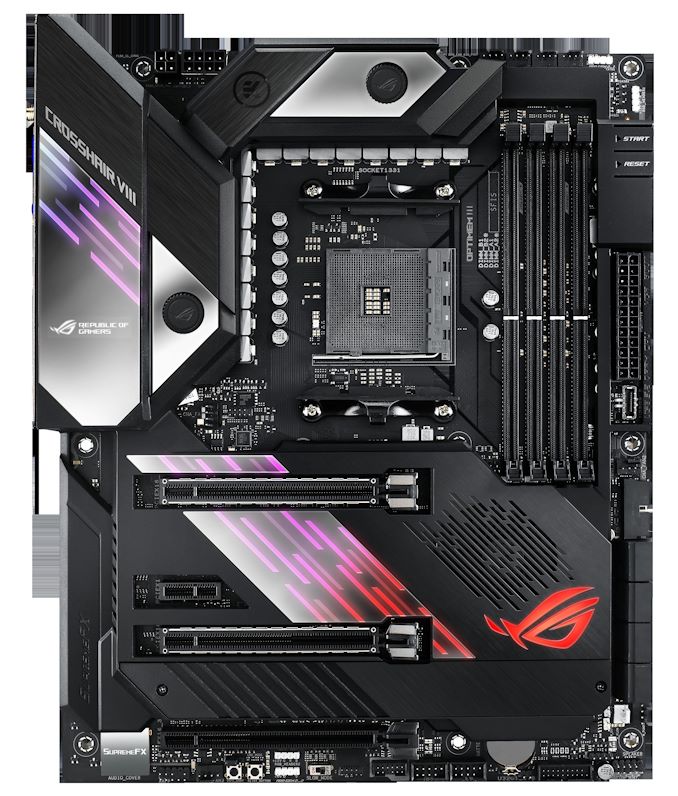The AMD X570 Motherboard Overview: Over 35+ Motherboards Analyzed
by Gavin Bonshor on July 9, 2019 8:00 AM ESTASUS ROG Crosshair VIII Formula
The ASUS ROG X570 Crosshair VIII Formula represents its flagship X570 entry onto the market with some very notable features, including a revamped design with a strong focus on performance, and ROG themed aesthetics. First of all, the ROG Crosshair VIII Formula uses EKWB heatsinks which can be connected to a custom water cooling loop for better power delivery temperatures, or as passive cooled. This has been seen on numerous iterations of its Maximus Formula boards created for Intel chipsets. This marks a shifting tide where ASUS seem to have confidence in AMD and the ability of its 7nm Ryzen 3000 processors, by opting for such a premium model for the X570 chipset.
One of the main focal points of the X570 chipset is its native PCIe 4.0 support. The ASUS ROG Crosshair VIII Formula has three-full length PCIe 4.0 slots operating at x16, x8/x8, and x8/x8/x4, with the final x4 coming from the chipset. This allows users to use two-way NVIDIA SLI and two-way AMD Crossfire multi-graphics card configurations. For add-on cards, a single PCIe 4.0 x1 slot is also present. There are also four DDR4 memory slots with a maximum supported capacity of up to 128 GB. Also included are a LiveDash OLED screen, a full metal backplate for a more rigid frame, and ROG armor across the majority of the PCB; not to forget about the swathe of RGB LED zones and the integrated fan within the chipset heatsink. On the rear of the board is a metal backplate which adds reinforcement to keep the board's structure intact.
On the componentry, the Crosshair VIII Formula uses a premium controller set with the most notable inclusions coming on the networking side. An Aquantia AQC111 5 GbE controller with a secondary Intel I211AT gigabit chip offers users dual LAN, but more impressively, ASUS has jumped onto the Wi-Fi 6 bandwagon by including the new Intel AX200 2x2 Wi-Fi adapter. The onboard audio is controlled by the Realtek SupremeFX S1220 HD audio codec. On the rear panel is a wide array of connections including seven USB 3.1 G2 Type-A, one USB 3.1 G2 Type-C, and four USB 3.1 G1 Type-A ports. Users can add to this with one USB 3.1 G2, two USB 3.1 G1 and two USB 2.0 front panel headers, with the USB 3.1 G2 offering one additional port, and the rest each offering an additional two ports per header.
The ASUS ROG X570 Crosshair VIII Formula is a mixture of premium controllers, quality features, and classic Formula aesthetics due to the implementation of an EKWB water block to keep the power delivery cool. This not only adds extra weight to the board but also cost and that is represented with an MSRP of $700.












225 Comments
View All Comments
isthisavailable - Wednesday, July 10, 2019 - link
The industry needs to make up its mind when it comes to USB C. Laptops are launching with only USB C and meanwhile $700 motherboards only have 1 USB C port and 8+ "outdated" USB A'sThe_Assimilator - Wednesday, July 10, 2019 - link
It's almost like there's a huge amount of peripherals with USB-A connectors that people who use PCs expect to continue to work when they upgrade! Isn't backwards compatibility a funny feature?Meanwhile, the only peripherals that laptops generally use are docks, hubs, and storage devices - all of which have USB-C versions out the wazoo.
naris - Wednesday, July 10, 2019 - link
Why are memory speeds and channels show & discussed when talking about chipsets when the memory controllers are in the CPUs? Memory controllers have not been in chipsets for many years now!halfflat - Wednesday, July 10, 2019 - link
ECC support can be hard to verify for mere mortals; collating (or even better, verifiying) ECC capability on these motherboards would be an extremely useful addition to the article.ishkatar - Wednesday, July 10, 2019 - link
Does any of the boards support Raid 5? I only see 0, 1 and 10.Zibi - Wednesday, July 10, 2019 - link
You don't want to use RAID 5 without proper RAID Controller with cache.That means dedicated card.
Actually from performance / security perspective RAID 10 is pretty OK.
The_Assimilator - Wednesday, July 10, 2019 - link
AMD dropped RAID-5 support upon introduction of the AM4 socket (remember, chipset functionality like RAID is now a CPU function). I don't have an issue with that, since -5 is a very uncommon use-case in consumer workloads and if you want to do -5 right, you really want a hardware RAID card with a BBU.But -5 is pretty much dead anyway due to ever-increasing drive sizes - the rebuild time on anything over 1TB is horrendous, what you really want in such a scenario is RAID-6, and no consumer motherboard every has or will support that.
And please don't tell me you're using RAID-5 for data integrity, because invisible corruption is a thing that I have experienced personally. If you want *actual* data integrity, use Windows Storage Spaces or RAID-10, and as a last resort RAID-6.
Arbie - Wednesday, July 10, 2019 - link
There must be something you left out of this roundup. Whatever it was, please go back and put it in, and next time get it right. Thanks.Korguz - Wednesday, July 10, 2019 - link
huh ????Gastec - Wednesday, July 10, 2019 - link
That $700 must be an error right, perhaps of judgement?